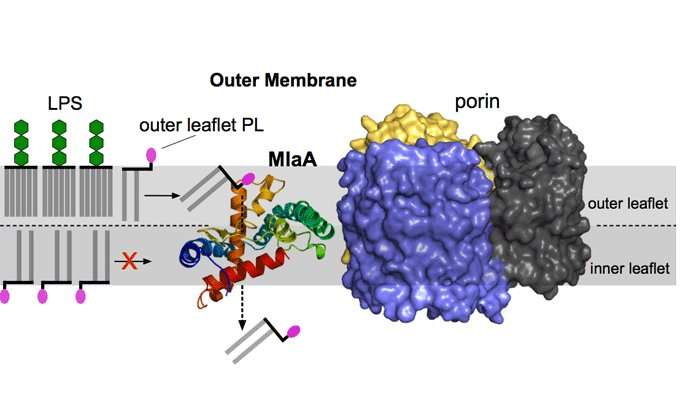The importance of asymmetry in bacteria

New research published in Nature Microbiology has highlighted a protein that functions as a membrane vacuum cleaner and which could be a potential new target for antibiotics.
The Newcastle University team reveal how the removal of certain lipids from the outer membrane may provide a vulnerability for gram-negative bacteria. They propose that this system could be exploited by drugs to decrease bacterial virulence, and to make various antibiotics more effective.
Cleaning the bacterial membrane
Gram-negative bacteria such as E. coli have two membranes, an inner membrane and an outer membrane.
The outer membrane is an asymmetric bilayer with an inner leaflet of phospholipids and an outer leaflet composed almost exclusively of lipopolysaccharide.
The lipopolysaccharide forms a sugar-coated layer on the surface of Gram-negative bacteria that is a very effective barrier for greasy, hydrophobic molecules and causes resistance towards antibiotics and other harmful compounds.
However, phospholipids from the inner leaflet spontaneously accumulate in the outer leaflet of the outer membrane, forming "islands" amid the lipopolysaccharide that increase the outer membrane permeability of toxic compounds. Those phospholipid molecules need to be removed from the outer leaflet to restore the outer membrane permeability barrier and asymmetry.
This process is carried out by the maintenance of lipid asymmetry (Mla) system, which is present in most Gram-negative bacteria. The MlaA protein, the focus of the research, is the outer membrane component of the Mla system.
Lead author and Professor of Membrane Protein Structural Biology within the Institute for Cell and Molecular Biosciences at Newcastle University, Bert van den Berg explained: "Our three-dimensional structures and functional data show that MlaA forms a donut in the inner leaflet of the outer membrane. This binds phospholipids from the outer leaflet and removes these via the central channel, somewhat similar to a vacuum cleaner.
"Our study illuminates a fundamental and important process in Gram-negative bacteria and is a starting point to determine whether the Mla system of Gram-negative pathogens could be targeted by drugs to decrease bacterial virulence, and to make various antibiotics more effective."
The Institute for Cell and Molecular Biosciences aims to support and develop the highest quality research to understand fundamental features of the working cells placing special emphasis on problems relevant to medicine. The team from the Institute working with their international collaborators will now continue study of the MlaA protein as a target for antiobiotics.
More information: Javier Abellón-Ruiz et al. Structural basis for maintenance of bacterial outer membrane lipid asymmetry, Nature Microbiology (2017). DOI: 10.1038/s41564-017-0046-x
Journal information: Nature Microbiology
Provided by Newcastle University


















